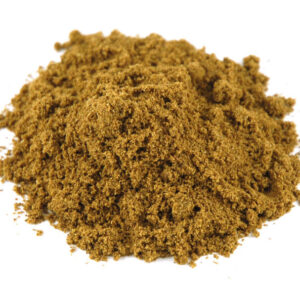Description
In the traditional Europian cuisine, caraway seed is one of the dominant spice featuring in several savory dishes. Strongly aromatic, caraway is a member of parsley or Umbelliferae family; a large family of herbs that also includes commonly known herbs and spices such as dill, anise, fennel, cumin, etc.
Scientific name of caraway is, Carum carvi.
Caraway is grown extensively all over Europe, North Africa, and Asia Minor regions. This biennial, herbaceous plant blooms creamy flowers in umbels once in every two years. It grows to about 2 feet in height and bears small feathery leaves. Caraway seeds, having similar in appearance as that of cumin, are crescent in shape, dark brown, with up to five stripes (ribs) running lengthwise.
Caraway generally harvested during early hours of the day to avoid spilling of its seeds on the ground. They are then staked in bundles and allowed to dry under sunlight, and their seeds then threshed, either mannually or using machines.
Health benefits of caraway seeds
- In addition to their use in traditional medicines, caraway seeds have their own food value, and indeed, have several health benefiting nutrients, minerals, vitamins and anti-oxidants.
- Caraway seeds are rich source of dietary fiber. 100 g seeds provide 38 g of fiber, 100% of daily recommended intake of fiber. Soluble as well as insoluble dietary fiber increase bulk of the food and help prevent constipation by speeding up its movement through the gut. In fact, gastro-intestinal transit time of food is greatly decreased.
- Fiber also binds to toxins in the food and helps protect the colon mucus membrane from cancers. In addition, dietary fibers bind to bile salts (produced from cholesterol) and decrease their re-absorption in colon, thus help lower serum LDL cholesterol levels.
- Caraway contains several health benefiting essential oils. Principle volatile compounds are carvone, limonene, carveol, pinen, cumuninic aldehyde, furfurol, and thujone. These active principles in the caraway seeds are known to have antioxidant, digestive, carminative, and anti-flatulent properties.
- Caraway has several health benefiting flavonoid antioxidnats such as lutein, carotene, crypto-xanthin andzea-xanthin. These compounds are indeed functions as powerful anti-oxidants by removing harmful free radicals from the body thus protect from cancers, infection, aging and degenerative neurological diseases.
- Caraway spice is an excellent source of minerals like iron, copper, calcium, potassium, manganese, selenium, zinc and magnesium. Copper is required in the production of red blood cells. Iron is required for red blood cell formation. Zinc is a co-factor in many enzymes that regulate growth and development, sperm generation, digestion and nucleic acid synthesis. Potassium is an important component of cell and body fluids that helps controlling heart rate and blood pressure. Manganese is used by the body as a co-factor for the powerful anti-oxidant enzyme, superoxide dismutase.
- The seeds indeed are the storehouse for many vital vitamins. Vitamin A, vitamin E, vitamin C as well as many B-complex vitamins like thiamin, pyridoxine, riboflavin, and niacin particularly are concentrated in the caraway seeds.
Selection and storage
Caraway seeds can be available year around in the markets either in the form of seeds or in ground-powder forms. In the store, buy whole caraway seeds instead of its powder since, oftentimes it may contain adulterated spicy powders.
Once at home, the seeds can be stored in cool, dry, dark place in air sealed containers for many months, and can be milled using hand mill whenever required. Ground and powdered caraway should be stored inside the refrigerator in airtight containers, and should be used as early as possible since it loses its flavor rather quickly.
Medicinal uses
- Caraway water is sometimes used in treating flatulence and indigestion in traditional medicines, especially used to relive infantile colic.
- It is also used in pharmaceuticals as flavoring agent in mouthwash and gargle preparations.
- Caraway extraction is used as a rubefacient (to soothe muscle sores), clear the cold, as a remedy in bronchitis and irritable bowel syndrome in many traditional medicines.
Culinary uses
Caraway seeds have a warm, sweet, and slightly peppery aroma when squeezed between index and thumb fingers. Its seeds are used extensively in European and Mediterranean cooking.
In order to keep fragrance and flavor intact, caraway seeds are generally roasted gently under light heat and ground just before using them in a recipe.
Here are some serving tips:
- Caraway seed is widely used as a savory spice. It is principally added in cooking as a condiment, and flavoring base.
- It features in savory dishes, including cabbage soups, sauerkraut, and salads.
- Caraway gives a pleasant aroma to breads, cakes, biscuits, and cheese.
- In addition, along with other spicy items, they are being used to season sausage and other meat preparations.




Reviews
There are no reviews yet.